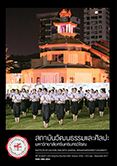PRASAT WAT PRANG THONG AT AMPHOE MUENG, NAKHON RATCHASIMA PROVINCE : THE CONVERTING OF KHMER TOWERS AND THE INSPIRATION BY THE SQUARE BELL-SHAPED CHEDI OR BUA LIAM OF LAN CHANG ART
Keywords:
Converting, Khmer Towers, the Square Bell-Shaped ChediAbstract
The article entitled PRASAT WAT PRANG THONG AT AMPHOE MUENG, NAKHON RATCHASIMA PROVINCE: THE CONVERTING OF KHMER TOWERS AND THE INSPIRATION BY THE SQUARE BELL-SHAPED CHEDI OR BUA LIAM OF LAN CHANG ART aims to present an analysis of the converting of Khmer Towers to Chedi in the example of Prasat Wat Prang Thong. The article entitled PRASAT WAT PRANG THONG AT AMPHOE MUENG, NAKHON RATCHASIMA PROVINCE: THE CONVERTING OF KHMER TOWERS AND THE INSPIRATION BY THE SQUARE BELL-SHAPED CHEDI OR BUA LIAM OF LAN CHANG ART aims to present an analysis of the converting of Khmer Towers to Chedi in the example of Prasat Wat Prang Thong. There were some differences between Khmer Towers (or Khmer Prasat) and Lan Chang Chedi. The explanation included the compositions of Khmer Towers: Base portion, the body of Prasat (Ruen That) and the top of this Prasat. The most changes that could be seen were the body and the top of the Prasat. Although the Khmer Towers at Wat Prang Thong was small, but it was so interesting about the style of converting. They chose the style of Square Bell-Shaped Chedi (Bua Liam) of Lan Chang Art for converting to new Chedi. It has been a famous style in Northeast of Thailand since 22nd Century Buddhist Era. The study of converting Prasat Wat Prang Thong found that the use of Square Bell-Shaped Chedi of Lan Chang Art to converting the top of Prasat was an intermixture of the Khmer arts and Lao arts in the same archaeological site. So the site was a symbol showing a change of religious belief from Brahmanism to Buddhism and emigration of people from Laos.
Downloads
Downloads
Published
How to Cite
Issue
Section
License
บทความทุกบทความที่ได้รับการตีพิมพ์ถือเป็นลิขสิทธิ์ของวารสารสถาบันวัฒนธรรมและศิลปะ มหาวิทยาลัยศรีนครินทรวิโรฒ


